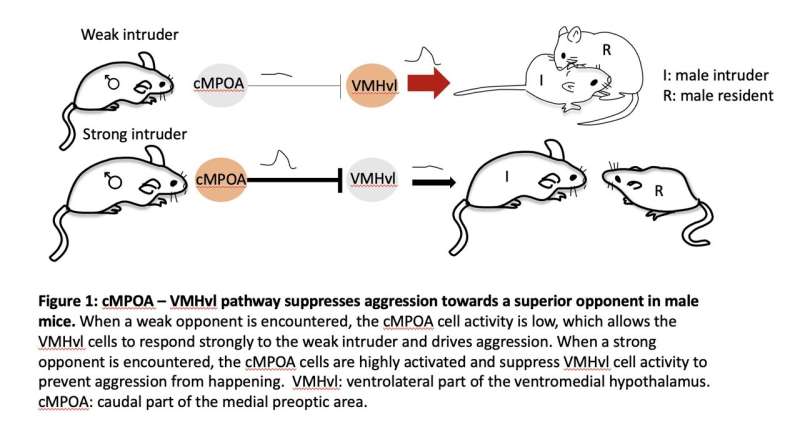A neural circuit that suppresses male aggression when an opponent is physically advantaged


For decades, neuroscientists have been trying to understand the neural mechanisms underpinning different social behaviors, including aggression. Aggressive, violent, or confrontational behaviors are common among humans and many animal species, yet the neural processes supporting or suppressing these behaviors have not been fully unveiled yet.
Researchers at New York University Langone Medical Center recently unveiled an area in the hypothalamus, brain region influencing the nervous system and the release of hormones, that suppresses aggression in male mice when they are confronting a stronger or physically “superior” opponent. Their findings, published in Nature Neuroscience, shed some new light on the neural pathways modulating aggression in animals and potentially also humans.
“I have been studying aggression circuits in mice since I started my lab in 2010,” Dr. Dayu Lin, one of the researchers who carried out the study, told Medical Xpress. “Previously, we found that VMHvl is an essential region for generating aggression, so we had our eyes on this area for a while. MPOA is the top region that projects to the VMHvl, but its function in aggression is unclear, as traditionally MPOA is considered a key region for sexual behaviors.”
While conducting their studies, Lin and her colleagues realized that rostral (i.e., frontal) and caudal (i.e., posterior) parts of the MPOA, an area of the hypothalamus, responded differently while mice were socially interacting with each other. They found that the caudal MPOA tended to be more active during interactions between two males than during interactions between male and female mice.
“When we manipulated the caudal MPOA, we found that aggression is strongly suppressed,” Lin said. “We then considered the potential situation under which male aggression towards another male could be suppressed. This led us to discover that cMPOA cell activity increases when a male encounters a stronger opponent.”
To conduct their recent experiments, the researchers used a combination of optogenetic and chemogenetic techniques. They recorded calcium activity in the mice’s brain using fiber photometry, an optogenetic technique, and also collected patch clamp recordings in slices of the mouse brain.
Patch clamp recording is a technique that entails filling a hollow glass tube with an electrolyte solution and a recording electrode, which is in turn connected to an amplifier that touches isolated cells. This allows researchers to measure long-term changes in the functions of specific neurons looking at the brain tissue of deceased animals. This technique revealed that MPOA cells directly synapse onto VMHvl cells and inhibit them.
Using optogenetic techniques, Lin and her colleagues also inhibited or activated cells in the cMPOA of living male mice and observed their resulting behavior during social interactions. Interestingly, the inhibition of these cells appeared to increase the male mice’s aggression towards other males, while activating them decreased the mice’s aggressive behaviors.
“Our findings suggest that cMPOA cells naturally suppress aggression,” Lin explained. “We found that cMPOA cells project to and inhibit VMHvl cells. In addition, inhibiting cMPOA to VMHvl projection caused an increase in aggression even towards stronger males, while activating the pathway decreased aggression. We then examined the in vivo activity of cMPOA and found that the cells are activated more by stronger males than weaker males.”
Overall, the findings gathered Lin’s lab suggest that the posterior part of the MPOA can significantly influence aggressive behavior between male mice. Specifically, this area of the hypothalamus appears to reduce aggression towards a stronger male opponent, by suppressing activity in the VMHvl.
“Our works discovered a new pathway that suppresses aggression towards improper targets,” Lin said. “This is central for the survival of animals including humans as misdirected aggression could have severe, even deadly, consequences. We also discovered high plasticity of the cMPOA cell responses after the social experience of losing.”
The recent work by this team of researchers provides some new valuable insight about the complex neural underpinnings of aggression, particularly showing how the brain of mice prevents disadvantageous fighting. In the future, it could pave the way for interesting new discoveries about how the MPOA influences aggressive behaviors, potentially also informing clinical studies on humans with aggressive or violent tendencies.
“MPOA and VMHvl are sexually dimorphic regions,” Lin added. “It will now be interesting to see whether the same circuit exists in females. In our next works, we are also interested in understanding the synaptic and cellular mechanisms that cause the response changes of MPOA cells to the stronger male after defeat.”
More information:
Dongyu Wei et al, A hypothalamic pathway that suppresses aggression toward superior opponents, Nature Neuroscience (2023). DOI: 10.1038/s41593-023-01297-5
Journal information:
Nature Neuroscience
Source: Read Full Article




